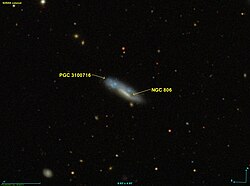| NGC 806 | |
|---|---|
 NGC 806 (SDSS) | |
| Observation data (J2000.0 epoch) | |
| Constellation | Cetus |
| Right ascension | 02h 03m 31.15s [1] |
| Declination | −09° 56′ 00.15″ [1] |
| Redshift | 0.013156 [1] |
| Heliocentric radial velocity | 3944 ± 9 km/s [1] |
| Distance | 166 Mly [2] |
| Apparent magnitude (V) | 14.10 [3] |
| Apparent magnitude (B) | 14.80 [3] |
| Characteristics | |
| Type | Scd pec? HII [1] |
| Apparent size (V) | 1.2 x 0.4 [1] |
| Other designations | |
| PGC 7835, MCG -2-6-21 | |
NGC 806 is a spiral galaxy approximately 166 million light-years away from Earth in the constellation Cetus. [1] It was discovered by American astronomer Lewis A. Swift on November 1, 1886 with the 16" refractor at Warner Observatory. [4]
